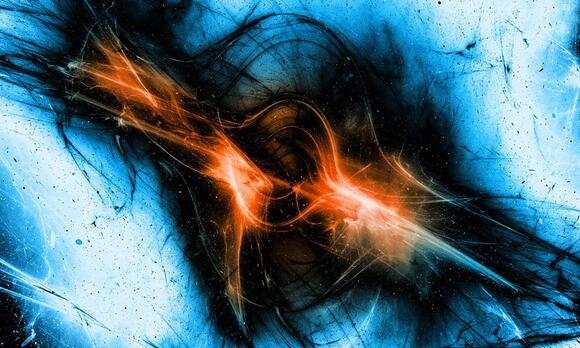
The universe has always held mysteries that spark our curiosity. As we currently understand it, the fabric of the universe comprises three primary components: 'normal matter,' 'dark energy,' and 'dark matter.' However, new research is turning this established model on its head.
Enter Rajendra Gupta, a seasoned physics professor who isn't afraid to question the status quo. With years of research under his belt, Gupta is shaking up our understanding of the universe.
Gupta, based at the University of Ottawa , conducted a study that suggests we might not need dark matter or dark energy to explain the workings of the universe. This bold claim is turning heads in the scientific community.
"Tired light" and the CCC theory
At the core of Gupta's research is a model that combines two theories: covarying coupling constants (CCC) and "tired light" (TL).
We've always been taught that the fundamental constants of nature -- like the speed of light or the charge of an electron -- are unchanging. But what if they aren't fixed after all?
The CCC theory suggests these constants might actually vary across the universe. If that's the case, it could alter our understanding of everything from the tiniest particles to the largest galaxies.
Then there's the "Tired Light" idea. Normally, we think the redshift of light from distant galaxies -- the way light stretches into longer, redder wavelengths -- is because the universe is expanding.
But the TL model offers a different take: maybe light loses energy over vast distances. This energy loss would cause the redshift without needing the universe to expand.
So, what happens when you put these two theories together? The CCC+TL model aims to provide a new framework for understanding cosmic phenomena .
By considering that constants might change and that light could lose energy over time, this model offers alternative explanations for observations that have puzzled scientists for decades.
Why most scientists think dark matter is real
So, why do we think dark matter is real if we can't see it? Back in the 1930s, an astronomer named Fritz Zwicky noticed that galaxies in a cluster were moving in ways that didn't match up with the visible mass.
Something unseen was exerting a gravitational pull on them. Since then, more evidence has surfaced, like the way galaxies spin -- they rotate faster than they should if only visible matter was involved.
According to most theories , dark matter plays a huge role in how the universe works. It seems to hold galaxies together, acting like an invisible glue.
Without it, galaxies might not have enough mass to stay intact. It also affects how light travels through space, bending it in ways that help us map out where dark matter might be hiding .
Questioning the need for dark matter
For years, dark matter has been the go-to explanation for the behavior of galaxies and the movement of stars.
It's been thought to make up about 27% of the universe, with ordinary matter accounting for less than 5%, and the rest being dark energy .
But Gupta's findings throw a wrench into this model.
"The study's findings confirm our previous work, which suggested that the universe is 26.7 billion years old, negating the necessity for dark matter's existence," he explains.
"Contrary to standard cosmological theories where the accelerated expansion of the universe is attributed to dark energy, our findings indicate that this expansion is due to the weakening forces of nature, not dark energy ," Gupta continues.
Redshifts and cosmic observations
A significant part of Gupta's research focuses on "redshifts," where light stretches toward the red end of the spectrum as it travels through space.
By analyzing data on how galaxies are distributed at low redshifts and the patterns observed in the early universe at high redshifts, he builds a case against the existence of dark matter.
"There are several papers that question the existence of dark matter, but mine is the first one, to my knowledge, that eliminates its cosmological existence while being consistent with key cosmological observations that we have had time to confirm," Gupta confidently concludes.
What does all of this mean?
If the CCC+TL model holds true, it could turn much of our current understanding on its head. It might offer new explanations for things like the cosmic microwave background radiation or the formation and evolution of galaxies.
Gupta's theory challenges the widely accepted Big Bang theory and could open up new avenues of thought in cosmology.
Critics point out that there's a wealth of data supporting current models, like the constancy of physical laws and the expansion of the universe .
The CCC+TL model needs to provide testable predictions that can be confirmed or refuted through observations and experiments.
Dark matter, Big Bang, and next steps
So, where do we go from here?
Researchers are hard at work trying to find ways to test the CCC+TL model. They're looking at distant stars, measuring cosmic radiation, and analyzing vast amounts of data.
As technology advances, especially with more powerful telescopes and detectors, we might gather the evidence needed to confirm or challenge these new theories.
In the end, the pursuit of understanding the universe is like assembling a giant puzzle without knowing the final picture.
Each new piece or idea helps us see a bit more, even if it means rethinking parts we thought we understood.
Whether the CCC+TL model becomes a key part of cosmology or leads us to other discoveries, it's all part of the exciting journey to comprehend the cosmos.
The full study was published in The Astrophysical Journal .
-----
Like what you read? Subscribe to our newsletter for engaging articles, exclusive content, and the latest updates.
Check us out on EarthSnap , a free app brought to you by Eric Ralls and Earth.com.
-----


 Local News
Local News
